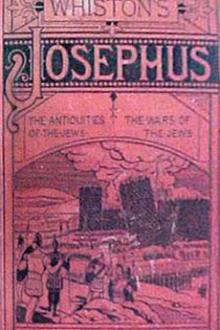The Antiquities of the Jews by Flavius Josephus (top fiction books of all time txt) 📖

- Author: Flavius Josephus
- Performer: 1600964370
Book online «The Antiquities of the Jews by Flavius Josephus (top fiction books of all time txt) 📖». Author Flavius Josephus
6. Moreover Hiram, king of Tyre, when he had heard that Solomon succeeded to his father's kingdom, was very glad of it, for he was a friend of David's. So he sent ambassadors to him, and saluted him, and congratulated him on the present happy state of his affairs. Upon which Solomon sent him an epistle, the contents of which here follow:
Solomon To King Hiram.
"5 Know thou that my father would have built a temple to God, but was hindered by wars, and continual expeditions; for he did not leave off to overthrow his enemies till he made them all subject to tribute. But I give thanks to God for the peace I at present enjoy, and on that account I am at leisure, and design to build a house to God, for God foretold to my father that such a house should be built by me; wherefore I desire thee to send some of thy subjects with mine to Mount Lebanon to cut down timber, for the Sidonians are more skillful than our people in cutting of wood. As for wages to the hewers of wood, I will pay whatsoever price thou shalt determine."
7. When Hiram had read this epistle, he was pleased with it; and wrote back this answer to Solomon.
Hiram To King Solomon.
"It is fit to bless God that he hath committed thy father's government to thee, who art a wise man, and endowed with all virtues. As for myself, I rejoice at the condition thou art in, and will be subservient to thee in all that thou sendest to me about; for when by my subjects I have cut down many and large trees of cedar and cypress wood, I will send them to sea, and will order my subjects to make floats of them, and to sail to what place soever of thy country thou shalt desire, and leave them there, after which thy subjects may carry them to Jerusalem. But do thou take care to procure us corn for this timber, which we stand in need of, because we inhabit in an island."
8. The copies of these epistles remain at this day, and are preserved not only in our books, but among the Tyrians also; insomuch that if any one would know the certainty about them, he may desire of the keepers of the public records of Tyre to show him them, and he will find what is there set down to agree with what we have said. I have said so much out of a desire that my readers may know that we speak nothing but the truth, and do not compose a history out of some plausible relations, which deceive men and please them at the same time, nor attempt to avoid examination, nor desire men to believe us immediately; nor are we at liberty to depart from speaking truth, which is the proper commendation of an historian, and yet be blameless: but we insist upon no admission of what we say, unless we be able to manifest its truth by demonstration, and the strongest vouchers.
9. Now king Solomon, as soon as this epistle of the king of Tyre was brought him, commended the readiness and good-will he declared therein, and repaid him in what he desired, and sent him yearly twenty thousand cori of wheat, and as many baths of oil: now the bath is able to contain seventy-two sextaries. He also sent him the same measure of wine. So the friendship between Hiram and Solomon hereby increased more and more; and they swore to continue it for ever. And the king appointed a tribute to be laid on all the people, of thirty thousand laborers, whose work he rendered easy to them by prudently dividing it among them; for he made ten thousand cut timber in Mount Lebanon for one month; and then to come home, and rest two months, until the time when the other twenty thousand had finished their task at the appointed time; and so afterward it came to pass that the first ten thousand returned to their work every fourth month: and it was Adoram who was over this tribute. There were also of the strangers who were left by David, who were to carry the stones and other materials, seventy thousand; and of those that cut the stones, eighty thousand. Of these three thousand and three hundred were rulers over the rest. He also enjoined them to cut out large stones for the foundations of the temple, and that they should fit them and unite them together in the mountain, and so bring them to the city. This was done not only by our own country workmen, but by those workmen whom Hiram sent also. 6
CHAPTER 3. Of The Building Of This Temple
1. Solomon began to build the temple in the fourth year of his reign, on the second month, which the Macedonians call Artemisius, and the Hebrews Jur, five hundred and ninety-two years after the Exodus out of Egypt; but one thousand and twenty years from Abraham's coming out of Mesopotamia into Canaan, and after the deluge one thousand four hundred and forty years; and from Adam, the first man who was created, until Solomon built the temple, there had passed in all three thousand one hundred and two years. Now that year on which the temple began to be built was already the eleventh year of the reign of Hiram; but from the building of Tyre to the building of the temple, there had passed two hundred and forty years.
2. Now, therefore, the king laid the foundations of the temple very deep in the ground, and the materials were strong stones, and such as would resist the force of time; these were to unite themselves with the earth, and become a basis and a sure foundation for that superstructure which was to be erected over it; they were to be so strong, in order to sustain with ease those vast superstructures and precious ornaments, whose own weight was to be not less than the weight of those other high and heavy buildings which the king designed to be very ornamental and magnificent. They erected its entire body, quite up to the roof, of white stone; its height was sixty cubits, and its length was the same, and its breadth twenty. There was another building erected over it, equal to it in its measures; so that the entire altitude of the temple was a hundred and twenty cubits. Its front was to the east. As to the porch, they built it before the temple; its length was twenty cubits, and it was so ordered that it might agree with the breadth of the house; and it had twelve cubits in latitude, and its height was raised as high as a hundred and twenty cubits. He also built round about the temple thirty small rooms, which might include the whole temple, by their closeness one to another, and by their number and outward position round it. He also made passages through them, that they might come into on through another. Every one of these rooms had five cubits in breadth, 7 and the same in length, but in height twenty. Above these there were other rooms, and others above them, equal, both in their measures and number; so that these reached to a height equal to the lower part of the house; for the upper part had no buildings about it. The roof that was over the house was of cedar; and truly every one of these rooms had a roof of their own, that was not connected with the other rooms; but for the other parts, there was a covered roof common to them all, and built with very long beams, that passed through the rest, and through the whole building, that so the middle walls, being strengthened by the same beams of timber, might be thereby made firmer: but as for that part of the roof that was under the beams, it was made of the same materials, and was all made smooth, and had ornaments proper for roofs, and plates of gold nailed upon them. And as he enclosed the walls with boards of cedar, so he fixed on them plates of gold, which had sculptures upon them; so that the whole temple shined, and dazzled the eyes of such as entered, by the splendor of the gold that was on every side of them, Now the whole structure of the temple was made with great skill of polished stones, and those laid together so very harmoniously and smoothly, that there appeared to the spectators no sign of any hammer, or other instrument of architecture; but as if, without any use of them, the entire materials had naturally united themselves together, that the agreement of one part with another seemed rather to have been natural, than to have arisen from the force of tools upon them. The king also had a fine contrivance for an ascent to the upper room over the temple, and that was by steps in the thickness of its wall; for it had no large door on the east end, as the lower house had, but the entrances were by the sides, through very small doors. He also overlaid the temple, both within and without, with boards of cedar, that were kept close together by thick chains, so that this contrivance was in the nature of a support and a strength to the building.
3. Now when the king had divided the temple into two parts, he made the inner house of twenty cubits [every way], to be the most secret chamber, but he appointed that of forty cubits to be the sanctuary; and when he had cut a door-place out of the wall, he put therein doors of Cedar, and overlaid them with a great deal of gold, that had sculptures upon it. He also had veils of blue, and purple, and scarlet, and the brightest and softest linen, with the





Comments (0)